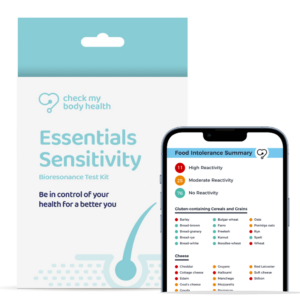
Medically reviewed by Sian Baker, Dip ION mBANT mCNHC
on April 9, 2024. To give you technically accurate, evidence-based information, content published on the Check My Body Health blog is reviewed by credentialed professionals with expertise in medical and bioscience fields.
A tamarind allergy occurs when you experience symptoms after eating tamarind or food containing tamarind. Symptoms can range from mild, such as itchy skin, to severe, like stomach pain. While serious allergies that cause breathing difficulties or anaphylaxis are rare, they are important to recognise.
Can you be allergic to tamarind?
Yes, it’s possible to have an allergic reaction to tamarind. Like other food allergies, a tamarind allergy results from the immune system’s overreaction to proteins found in tamarind, mistaking them for harmful invaders.
How common is a tamarind allergy?
Specific data on tamarind allergy prevalence is scarce, as it is less commonly reported than allergies to foods like nuts, shellfish, or dairy. However, as with any food allergy, individual susceptibility varies, and tamarind allergy can occur in both adults and children.
Signs & Symptoms of a Tamarind Intolerance or Allergy
Tamarind allergies and intolerances can manifest in various ways, impacting different people differently. Here’s what to look out for:
What are the symptoms of a tamarind allergy?
Symptoms of a tamarind allergy can resemble those of other food allergies and may include:
- Tingling or itching in the mouth
- Hives, rash, or itchy skin
- Swelling of the lips, face, tongue, throat, or other body parts
- Wheezing, nasal congestion, or trouble breathing
- Abdominal pain, diarrhoea, nausea, or vomiting
- Dizziness, lightheadedness, or fainting
In severe cases, tamarind allergies can lead to anaphylaxis, a life-threatening reaction requiring immediate medical attention.
What are the symptoms of a tamarind intolerance?
Unlike an allergic reaction, tamarind intolerance symptoms are generally less severe and relate to digestive issues, including:
- Stomach or intestinal pain
- Bloating
- Constipation or diarrhoea
- Fatigue
What is food intolerance?
Food intolerance arises when the body struggles to digest a specific food. This difficulty is not caused by the immune system but by the digestive system’s inability to process certain food components, leading to discomfort and other symptoms.
How common is a tamarind intolerance?
Given tamarind’s less prevalent use in Western diets compared to foods like wheat or dairy, reported cases of tamarind intolerance are uncommon. However, individual reactions to any food, including tamarind, can vary widely.
How do you test for a tamarind allergy or intolerance?
Identifying a tamarind allergy or intolerance involves several steps:
- Keep a food diary to track your diet and any symptoms that occur after eating tamarind.
- Consider an elimination diet, removing tamarind from your diet for a period to see if symptoms improve.
- Our food intolerance tests can pinpoint specific intolerances, including tamarind.
What foods should you avoid if you have a tamarind allergy or intolerance?
If you’re allergic or intolerant to tamarind, you should avoid foods and products containing tamarind, such as:
- Tamarind paste or concentrate
- Certain sauces and condiments that use tamarind as an ingredient
- Snacks or sweets flavoured with tamarind
- Some beverages, including certain sodas and cocktails, that may use tamarind for flavouring
10 alternatives to tamarind
If you need to avoid tamarind, consider these alternatives for similar tangy or sour flavours in your cooking:
- Lime or lemon juice
- Vinegar (apple cider, white wine, or balsamic)
- Amchur (dried mango powder)
- Pomegranate molasses
- Sumac
- Tamarillo (for a similar tangy flavour)
- Cranberry juice (concentrated or reduced)
- Green mangoes
- Kokum (in Indian cuisine)
- Hibiscus flowers (in teas or syrups)
How to test if you have a tamarind allergy or intolerance
To confirm a tamarind allergy or intolerance, consider undergoing a food allergy blood test or an advanced food intolerance test. These tests can provide a clear understanding of what foods you may need to avoid, including tamarind, to prevent unpleasant symptoms or reactions.
If you’re experiencing symptoms that may indicate a tamarind allergy or intolerance, it’s crucial to speak with a healthcare professional. Additionally, consider trying one of our intolerance tests for a comprehensive analysis of potential food sensitivities and intolerances.
Frequently Asked Questions about Tamarind Allergy
Can cooking tamarind reduce allergy risks?
Cooking can alter the proteins in some foods enough to reduce allergic reactions. However, with tamarind and most food allergies, the allergenic proteins are usually resilient to heat. Therefore, cooking tamarind is unlikely to significantly reduce allergy risks. Always consult with a healthcare professional regarding your specific allergy.
Is it possible to outgrow a tamarind allergy?
As with many food allergies, it’s possible, though not guaranteed, that children may outgrow a tamarind allergy. Adults with newly developed tamarind allergies are less likely to see their allergy disappear over time. Monitoring under medical supervision is essential.
Can tamarind cause cross-reactivity with other allergies?
Tamarind may cause cross-reactivity in individuals with allergies to birch pollen or other foods due to similarities in protein structures. Known as Oral Allergy Syndrome (OAS), this reaction occurs because the immune system recognises similar proteins in the food as those in pollen allergens
Tamarind is commonly used in a variety of cuisines, particularly Indian, Thai, and Mexican, and can be found in sauces, condiments, snacks, and beverages. Always check ingredient labels for tamarind and be cautious when eating out, as tamarind may be a hidden ingredient in dishes.
Conclusion
In summary, while tamarind allergy is less common than other food allergies, it’s crucial for those affected to avoid tamarind and related products to prevent allergic reactions. Understanding the symptoms, potential cross-reactivity with other allergies, and how to manage reactions is essential for living safely with a tamarind allergy.
For anyone suspecting a food allergy or intolerance, including to tamarind, consider getting tested. We offer a range of tests that can help identify food sensitivities and intolerances, aiding in the management of dietary restrictions for better health and well-being.




